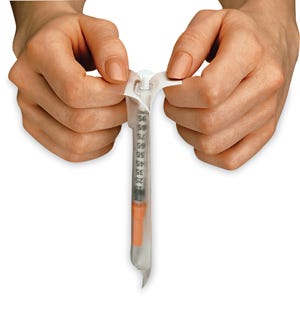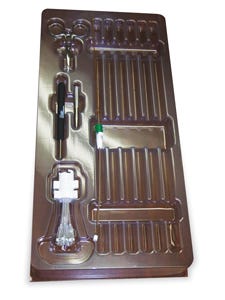The Pursuit of Sustainable Medical Packaging
January 30, 2014
|
Those responsible for the design, development and qualification of medical packaging, including medical devices, pharmaceuticals, in vitro diagnostics and biotechnology, to name a few key sectors, have a daunting challenge to achieve compliance with the general health and safety requirements put forth by the U.S. Food & Drug Administraton Code of Federal Regulations Title 21 CFR, Parts 800 to 1299. Adding sustainable packaging goals to that requirement list leads many of us to take the path of least resistance and shove sustainable packaging to the bottom of the list.
As the sustainable technology movement continues to grow, mature and become intrinsic to the business process, the medical technology sector is being tasked to incorporate sustainable technologies across its various sectors, with packaging being a huge target.
Sustainable packaging saves money
Sustainable packaging seems to be more of a comprehensive development approach than a single compliance goal. It's an exercise in continuous improvement for anyone engaged in its pursuit. The Sustainable Packaging Coalition describes sustainable packaging as:
• Beneficial, safe and healthy for individuals and communities throughout its life cycle;
• Meets market criteria for performance and cost;
• Sourced, manufactured, transported and recycled using renewable or recycled materials;
• Manufactured using clean production technologies and best practices;
• Made from materials healthy in all probable end-of-life scenarios;
• Designed to optimize materials and energy;
• Effectively recovered and utilized in biological and/or industrial cradle-to-cradle cycles.
|
Sustainable packaging is an exercise in continuous improvement... |
Primary package design for medical packaging is no exception. Plastics represent the lion's share of deployed materials, specifically for sterile packaging and primary container packaging. When evaluating plastic resins and converted film for a medical packaging application, it's necessary to investigate the issues of resin density, converted yield and package performance on the final package design. Work with your resin or converted-film supplier to evaluate the facts of resin/sheet density, price per pound, package performance per film/sheet thickness and yield. This will be a fruitful exercise in evaluating finished-package performance versus cost, based on the known data of density and a yield calculation. The higher-yield plastic may yield acceptable or improved performance (to be evaluated), and the higher yield should mean a lower cost to the medical manufacturer. Less plastic is used for the application, and this works towards a more sustainable package design.
Where the need exists for sterilization compatibility and sterility maintenance, primary medical packaging must comply with ISO 11607-1:2006, entitlted, “Packaging for Terminally Sterilized Medical Devices.”
Costs can be cut by eliminating certain levels of packaging and packaging components.
Medical-device packaging
In sterile barrier medical-device packaging, manufacturers should explore the clinical requirement for two sterile barriers on the medical device. Depending on the attributes of the device, including its size, geometry, complexity, number of components and the clinical procedure itself, having two sterile barriers is an unnecessary use of packaging materials and resources. Good packaging design and materials selection can allow for good practices in aseptic transfer with a single sterile barrier package. Eliminating materials is a sustainable packaging goal and a cost-savings or cost-avoidance activity.
For nonsterile medical applications, there is a greater opportunity to pursue even more sustainable packaging materials. The performance bar is set high when recycled content is present or, at the greenest end of the spectrum, biomaterials are used, in terms of having to match the properties of heat deflection, impact strength, sterilization compatibility and consistency of these properties that are usually provided by virgin resins.
Some of the primary workhorses in sterile medical packaging are modified polyethylene terephthalate glycol (PETG) and high-impact polystyrene (HIPS).
Many medical-packaging converters are investing in research and development for the next generation of polymers and manufacturing processes to maintain properties necessary for sterile barrier performance and continuous improvement along the sustainable packaging continuum.
Contact several medical packaging converters and discuss their product offerings along the lines of the use of recycled material in their extruded, rigid sheetstock (recycled polyethylene terephthalate [RPET]) for thermoforming, higher- yield plastics for thermoforming (amorphous PET [APET]) and the sandwiching of recycled process materials between virgin materials.
Secondary and tertiary package design
At levels beyond primary packaging, one can really get inventive with sustainable packaging designs. Secondary and tertiary packaging designs provide physical and environmental protection to the medical product.
Conventional cushioning and protective materials can be designed to use the minimal amount of material required to protect the product. Paperboard and corrugated can be deployed with post-consumer-recycled content.
A development tool for fragile medical products, such as medical electronic equipment, is the execution of a fragility assessment or damage-boundary-curve assessment of the unpackaged product.
This requires the use of a dynamics-test lab with equipment that provides test results for vibration and shock sensitivities. Testing can be conducted in compliance with the American Society of Testing and Materials (ASTM) Standard D3580, and the end result is a series of transmissibility plots describing the natural or resonant frequency of various components and the amplification reached at resonance.
This data can then be used to develop a package that requires the minimum amount of cushioning necessary to protect the medical product during shipping, handling and distribution.
A minimum of cushioning can often mean lower costs or cost avoidance for the packager.
The temperature factor
Temperature-sensitive products are another specialty category of medical packaging. This is a data-intensive niche, so the need exists to laboratory-test the product for its temperature profile or environmental temperature stability and use the data to custom design temperature protection with a minimum amount of packaging.
The EU Packaging Waste Directive
|
Even a medical-device package, above, can be made of sustainable materials. |
As an outcome of pursuing sustainable packaging, one good business decision is the pursuit of compliance to the European Union Packaging Waste Directive, electrical waste and electronic equipment (WEEE) and the restriction of hazardous substances (RoHS).
The EU Packaging Waste Directive (94/62/EC) is a hierarchy of prevention, recovery and disposal. Here are just a few of its requirements:
• The packaging must be the minimum weight and volume to maintain the necessary level of safety, hygiene and acceptance for the product and consumer.
• The packaging is manufactured in such a way as to minimize the presence of “noxious and other hazardous substances,” in residues from the recovery/disposal process.
•When intended for reuse, the packaging meets the requirements for safety in use and reuse, and is subsequently suitable for the appropriate recovery options.
• The packaging is suitable for recovery by recycling and/or composting and/or energy recovery.
• The packaging is manufactured so that four named heavy metals (cadmium, hexavalent chromium, lead and mercury) are collecdtively contained within stated concentration limits.
• Manufacturers and/or distributors of electronic and/or electrical equipment manage and pay for the collection and further handling of WEEE products, as well as provide WEEE-related information to customers.
• The EU RoHS directive restricts the use of certain hazardous substances in products.
Manufacturers must also provide data sufficient to demonstrate compliance with all of the stated, normative references within EN 13427:2004, which basically includes packaging requirements specific to: manufacturing, composition; source reduction; material recycling and recovery; energy recovery; composting and biodegradation; measuring and verifying the four heavy metals and other dangerous substances present in packaging and their release into the environment, parts 1 and 2.
This appears to be a daunting task. However, there are a few documents that can facilitate compliance by breaking down compliance to a prescribed set of tasks. These can be located with an internet search.
Additionally, several firms provide guidance on these European requirements. These compliance activities are in direct support of sustainable packaging goals, and can improve the marketability of the medical product.
Advancing packaging technology
Existing packaging designs can also be evaluated for use of minimal packaging materials, product protection, number of sterile barriers evaluated, the use of recycled materials or the use of higher-yield plastics, engineered temperature control and protection/cushioning.
Pursuing sustainable packaging materials can advance packaging technology within an organization as the upside of cost savings and cost avoidance. The market benefits of environmental compliance can help fuel the competitive advantage of “greener” packaging.
It appears that, from the amount of information available on this subject, everyone is taking packaging sustainability seriously.
Try working with packaging materials suppliers and converters as well as companies with testing, engineering and regulatory-consulting expertise. Your organization's ability to leverage packaging technology is a competitive advantage in the marketing of your medical product.
Prepared by Karen K. Greene, technical director of DDL ( www.testedandproven.com ). DDL offers medical device and packaging testing services, package design and packaging prototyping.
References: |
FDA, Title 21 Code of Federal Regulations Part 800-1200 (21 CFR Parts 800 to 1299). |
Packaging Guidelines v.1.0 © 2006 GreenBlue |
ISO 11607-1:2006 “Packaging for Terminally Sterilized Medical Devices,” Part 1. |
ASTM D3580, “Standard Test Method for Vibration (Vertical Linear Motion) Test of Products.” |
EU Packaging Waste Directive 94/62/EC. |
WEEE Directive-electrical waste and electronic equipment. |
RoHS Directives restriction of hazardous substances. |
EN 13427:2004: “Packaging Requirements for the use of European Standards in the Field of Packaging and Packaging Waste.” |
You May Also Like





